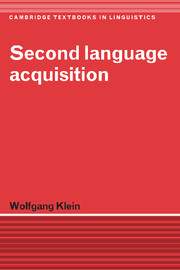Book contents
4 - The learner's four tasks
Published online by Cambridge University Press: 05 June 2012
Summary
The problem of analysis
The input available to the learner consists for the most part of complete, meaningful utterances embedded in a particular situational context. The perceived and processed information is of two kinds:
a complex sequence of acoustic signals which constitute the linguistic information proper, and
a complex of concurrent, chiefly visual signals which will be termed ‘parallel information’.
One of the speaker's problems is to segment the stream of acoustic signals into constituent units and to bring the latter into line with the parallel information on concurrent events which constitutes the situational context of the utterance. This is the problem of analysis.
This may be illustrated by the following example. Suppose you are a Japanese visitor and you happen to be in Germany without knowing a single word of German. You are having breakfast in your hotel with a couple of Germans. One of the Germans turns to you and produces a sequence of speech sounds like this:
(1) axkœnənzi:mi:rma:ldaszaltsraiçənbitə∫œ:n
In this transcription the intonation contour of the utterance has been omitted, and it is assumed that the native speaker happens to have perfect High German pronunciation. We further assume that you have been able to identify all the sounds correctly – a very unlikely thing for an untrained ear (cf. Lambert, 1977; and Rösel, 1980). In normal spelling (1) would be written as, Ach, können Sie mir mal das Salz reichen, bitte schön? (‘Oh could you please pass me the salt’).
- Type
- Chapter
- Information
- Second Language Acquisition , pp. 59 - 62Publisher: Cambridge University PressPrint publication year: 1986

